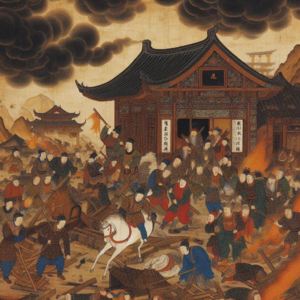Pogrom of the Caphirians: Difference between revisions
mNo edit summary Tag: 2017 source edit |
|||
| Line 27: | Line 27: | ||
[[Category:Daxia]] | [[Category:Daxia]] | ||
[[Category:Events]] | [[Category:Events]] | ||
[[Category:IXWB]] | |||
Revision as of 09:37, 24 June 2024
| Pogrom of the Caphirians | |
|---|---|
 | |
| Location | Rakin, Qian controlled Peratra |
| Date | August 1758 |
| Target | Caphirians, other foreigners |
Attack type | Daxian racialist reaction |
| Deaths | 1,500 |
| Injured | 3,500 |
| Perpetrators | Daxia |
The Pogrom of the Caphirians also known as the Rakin Pogrom was a pogrom that took place in Qian controlled Rakin, Peratra in August of 1758. The attack originally targeted wealthy Caphirians residing on the port city but eventually extended to other inhabitants of foreign origin. The pogrom was carried out by large mobs of Daxians and their Polynesian slaves over approximately five hours before the authorities managed to disperse the throngs by force; during this time at least 1,500 Caphirians and other foreigners were killed in their homes and on the streets while another 3,500 were wounded with knifes or bludgeoned with clubs. Accounts on what exactly started the massacre differ greatly, according to some witness statements the riot began when a wealthy Caphirian slave trader named as Baldogilo Serentesi whipped his Daxian maid in front of his house before ripping apart her dress whereupon an incensed mob set upon him with sticks and rocks, killing him. Afterwards the mob began to burn Serentesi's manor and all other adjacent houses in the Caphirian Quarter while also attacking other non-Daxians they came across; the violence escalated into a city-wide riot.
Background
The beginning of trading by the Qian dynasty with Sarpedon by way of the Southern route brought the Daxian people into regular contact with 'civilized western' foreigners outside of naval action and slavery. Exchanges with the Third Imperium and the Carto-Pelaxian Commonwealth proved so profitable that certain aspects of the long held Daxian Racialism espoused in Zhangwo ideology were quietly loosened. Regulations on foreigners living on Qian-controlled Peratra were adjusted to be less restrictive and this caused an influx of traders and businessmen of all stripes choosing to settle in various ports. Cities like Port Bondor, Rakin and Yishi developed their own foreign quarters in time; Rakin's Caphirian Quarter was noted to be very safe and clean. Nonetheless not all were pleased by the increased presence of outsiders, several secret societies existed among the settlers of Peratra that proclaimed the subcontinent as a Heaven granted land for Daxians, the presence of unenslaved foreigners was a violation. The arrival of ships and the disembarkation of their rowdy foreign crews also routinely increased tensions with locals. Instances of conflicts arising from deep seated Daxian racism, the drunkenness of foreigners or refusal to pay for goods and services and the presence of 'western' slaves (which might incense their compatriots) were common but usually quickly contained by the authorities.